Memory Scaling on Core i7 - Is DDR3-1066 Really the Best Choice?
by Gary Key on June 24, 2009 9:00 AM EST- Posted in
- Memory
Even though our DDR3-2000 kits were not cooperating with us, we were able to run a few benchmarks to determine which memory setting would be ideal at our 3.8GHz (19x200) processor speed. We arrived at this clock speed, as it is a free overclock with only VTT needing to be increased to handle our particular memory speeds and timings. We will take a look at other overclocked speeds and memory settings in the near future.
Everest 5.02.1765
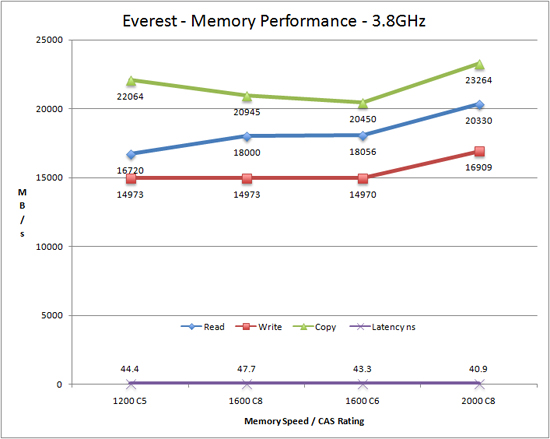
Going from 1250 C5 to 2000 C8 nets a 5% improvement in memory reads, 21% in writes, 13% in copy speeds, and 8% in latency. Interestingly enough, 1200 C5 provides excellent results compared to 1600 C8 and our application benchmarks reflect this fact.
AutoCAD 2009 x64
We utilize AutoCAD 2009 x64 and the Cadalyst Labs benchmark.

Just like our stock clock results, the 3D scores are respond better to the slower memory speeds. Once again, decreased latencies and greater bandwidth generally resulted in improved 2D and CPU scores.
3ds Max 2009 x64
We utilize a rather large mental ray image and track the time it takes to render it.
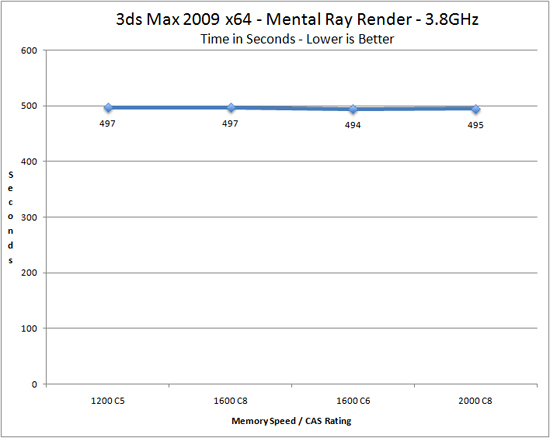
In our stock test we measured a 3% increase in performance (19 second reduction) moving from DDR3-1066 C7 to DDR3-1600 C6. In our overclock test the 2 second difference between 1200 C5 and 2000 C7 is minimal as clock speed is king at this point.
LightWave 3D 9.6 x64
We time the rendering of a single frame from an office building animation. The time to render the full scene is approximately four and a half hours.
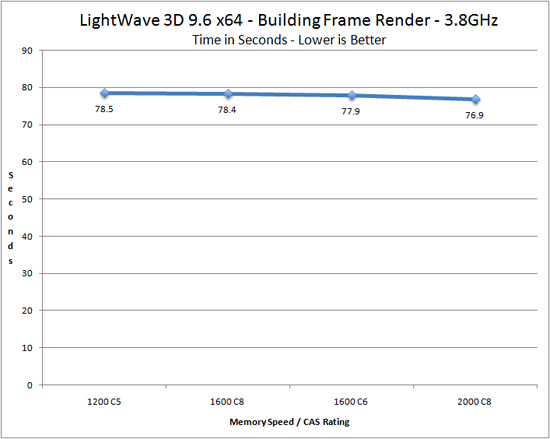
The stock test revealed a 6% advantage for DDR3-1866 C7 over DDR3-1066 C7. The overclock test indicates a 2% advantage for 2000 C8 compared to 1200 C5.
WinRAR 3.9b3 x64
This benchmark compresses our AT workload consisting of a main folder that contains 954MB of files in 15 subfolders. The result is a compressed file approximately 829MB in size.
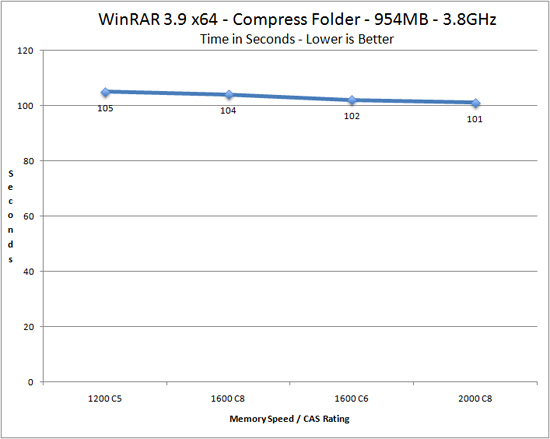
In our stock tests, going from DDR3-1066 C7 to DDR3-1866 C7 resulted in a 20% decrease in processing time. With our processor overclocked to 3.8GHz, this benchmark provides a 4% increase in performance when moving from 1200 C5 to 2000 C8.
MainConcept Reference 1.61
We set our profile to iPOD HQ NTSC and then transcode a 651MB 1080P file to a iPOD friendly 34.7MB file.
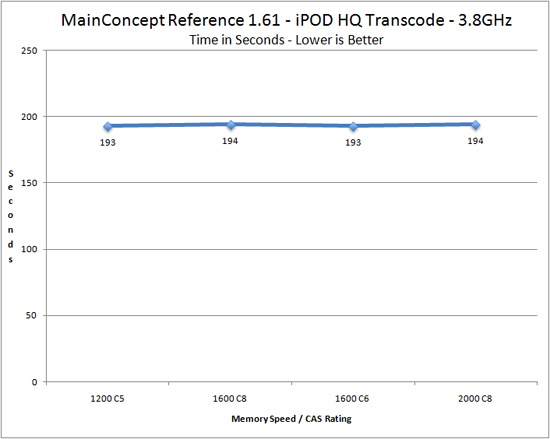
Our stock test showed a 3% improvement in performance when scaling from DDR3-1066 to DDR3-1866. Overclocking our system resulted in a .05% variation in the score with our two low latency settings performing ever so slightly better.










47 Comments
View All Comments
sonci - Thursday, June 25, 2009 - link
The title was enough,and yours is too..
goinginstyle - Wednesday, June 24, 2009 - link
I have no idea where you have been hiding Gary but it is great to see you back. I look forward to the AMD article and the individual module tests. If they are half as good as this, I will be one happy person. Any chance or comments on Virtualization benches under WIn7 with XP?duploxxx - Wednesday, June 24, 2009 - link
very nice article with real world applications, now can you pls do the same with amount of dimms used and finally kill this marketing hype?vailr - Wednesday, June 24, 2009 - link
Re:"Current JDEC specifications list 1.50V as the official voltage specification for DDR3 with a move to 1.35V in the near future and eventually to 1.20V."
How does DDR5 (already being used on some video cards) voltages compare with those numbers?
Any predictions on when DDR5 memory modules for main boards might be introduced?
Are lower latency DDR3 modules "in the works"?
Maybe such a thing as:
1333 MHz @4-4-4-12 & 1.20v, for example?
Also: Intel promotes the benefits of using Hafnium when producing their CPU's. Would Hafnium also benefit memory chips?
GourdFreeMan - Thursday, June 25, 2009 - link
The video cards you are thinking of use GDDR, not DDR. You will never find GDDR packaged on DIMMs for motherboard memory slots, but rather only as individual chips for graphics boards and consoles. Though they share some technologies, you would need a different memory controller to make use of it. Typically GDDR5 runs from 1V to 1.4V (the GDDR5 on the stock Radeon HD 4770 runs at 1.263V for example). Hafnium dioxide has already been used by some manufacturers as the dielectric material in DRAM capacitors, and I know NEC, at least, has already used Hafnium in transistor gates for embedded DRAM. As for higher speed and lower latency RAM, that is pretty much always in the works...Zorlac - Wednesday, June 24, 2009 - link
I have thought this all along, but was too lazy to prove it. Thanks Anand!!! :)Any idea when we will start seeing 4GB DIMMs for running 3x4GB kits?
Gary Key - Wednesday, June 24, 2009 - link
We just finished testing a 12GB 1600 C9 kit from Kingston, but the street price is $1400. I also have a 24GB kit from Corsair, but I will not even mention the cost on that one. We should see affordable (compared to buying 6x2GB) 12GB kits later this year in the 1333 C8 variety without ECC. I do have a 12GB ECC Kingston 1066 C8 kit arriving shortly, retail is about $320, to test in some workstation products.DXRick - Wednesday, June 24, 2009 - link
It looks like the sweet spot is 1600 C8 at around $100 for a 6BG kit.vol7ron - Wednesday, June 24, 2009 - link
agreed --- those saying 1333 really are saving the buckI would still like to see SuperPi tests, since they are a mathematical approach to memory performance.
Gary Key - Wednesday, June 24, 2009 - link
Super Pi results will come in Raja's 2000 shootout. However, most of the Super Pi program runs in cache and when it goes outside of it,it only hits a couple of ranks in short bursts (why bandwidth matters) and as a result a proper loading of the entire memory subsystem is not really tested thoroughly. That said, we will have a complete subsection on Super Pi for the overclocking crowd. :)